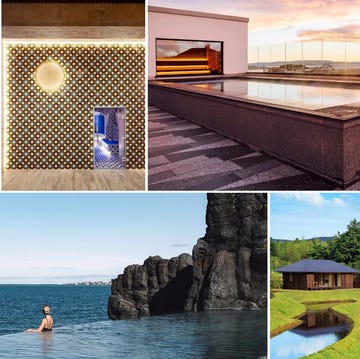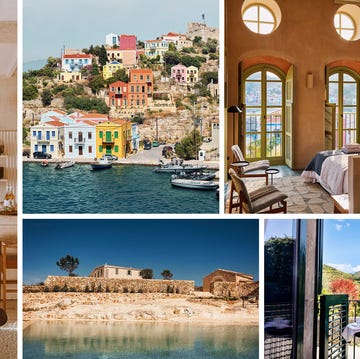At Six Senses Ibiza, the most coveted room is not a presidential suite. It’s the Cave Royale, a trio of underground chambers with a 1,300-square-foot sea-view terrace. The Cave Royale is part of the resort’s new extension, the Beach Caves, which includes a waterfront restaurant and multiple bars conceived by interior-design duo Diego Alonso and Alexeja Pozzoni. These man-made caverns are like a “hotel within a hotel,” says Alonso. “It’s been such a draw for guests that it’s given a whole new flow to the property.” And then there’s Cova Santa, a restaurant and club, also in Ibiza, that hosts some of the island’s coolest DJs and parties and is built around a natural cave. “Maybe with all that’s going on in the world, a cave is, in our subconscious, a place we feel safe in,” Pozzoni posits.
Francesca Amfitheatrof, artistic director of jewelry and watches at Louis Vuitton, offers another theory. She recently completed the transformation of a cave on the tiny Italian island of Ventotene into a spectacular holiday home with the help of the Roman architecture studio LaCap. “We are stuck in boxes all our lives, going from one square to a rectangle, so I think the organic shape of a cave is both comforting and enchanting,” she says. It is both seductive and soothing, she suggests, almost like “going back to the womb.”
While Amfitheatrof’s property is private, other spectacular cave hotels can be found elsewhere in Italy. In Sicily, there’s Locanda Don Serafino in Ragusa Ibla, with Kartell furniture and baths carved into the rock. In the most ancient part of the city of Matera, there’s the dramatic Sextantio Le Grotte della Civita, a cluster of 18 caves that the Italian hotelier and preservationist Daniele Kihlgren, along with British architect David Chipperfield, reimagined as minimalist spaces with freestanding Philippe Starck bathtubs and dozens of candles that are lit every evening.
Last summer, Kihlgren opened the neighboring Sextantio Il Palazzo della Civita, five rooms in a 17th-century palace that merges into the rock. Several caves on the property are now used to house local craft workshops, while another has been transformed into a contemporary art installation with soundscapes.
Another region famous for subterranean living is Cappadocia, Turkey, where one can explore underground cities and early Christian churches that are dug deep into the region’s soft volcanic rock. The most stylish and intimate cave hotel in the area is the five-room Serinn House in Ürgüp.
On the Greek island of Crete, Acro Suites is one of the most photographed resorts, thanks to its cliffside cave rooms with sea views. The grotto look has become so zeitgeist-y that some hoteliers are even designing lodgings to look like caves: In the case of the Hyades Mountain Resort in southern Greece, the owner had a cavernlike suite carved out of wood.






















